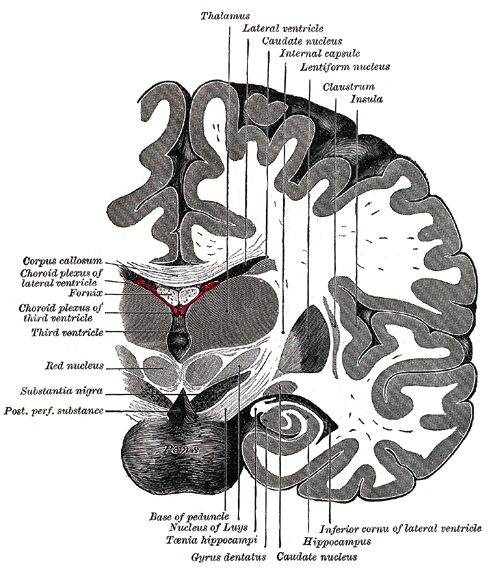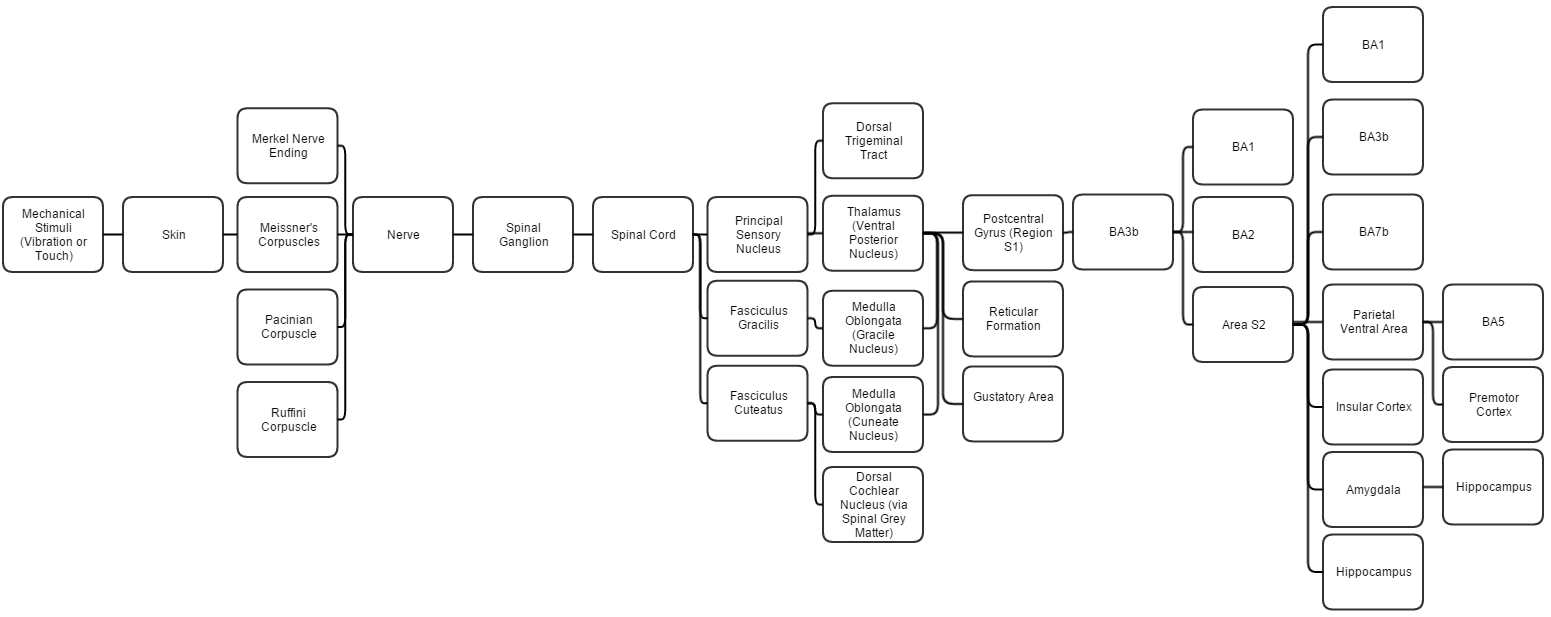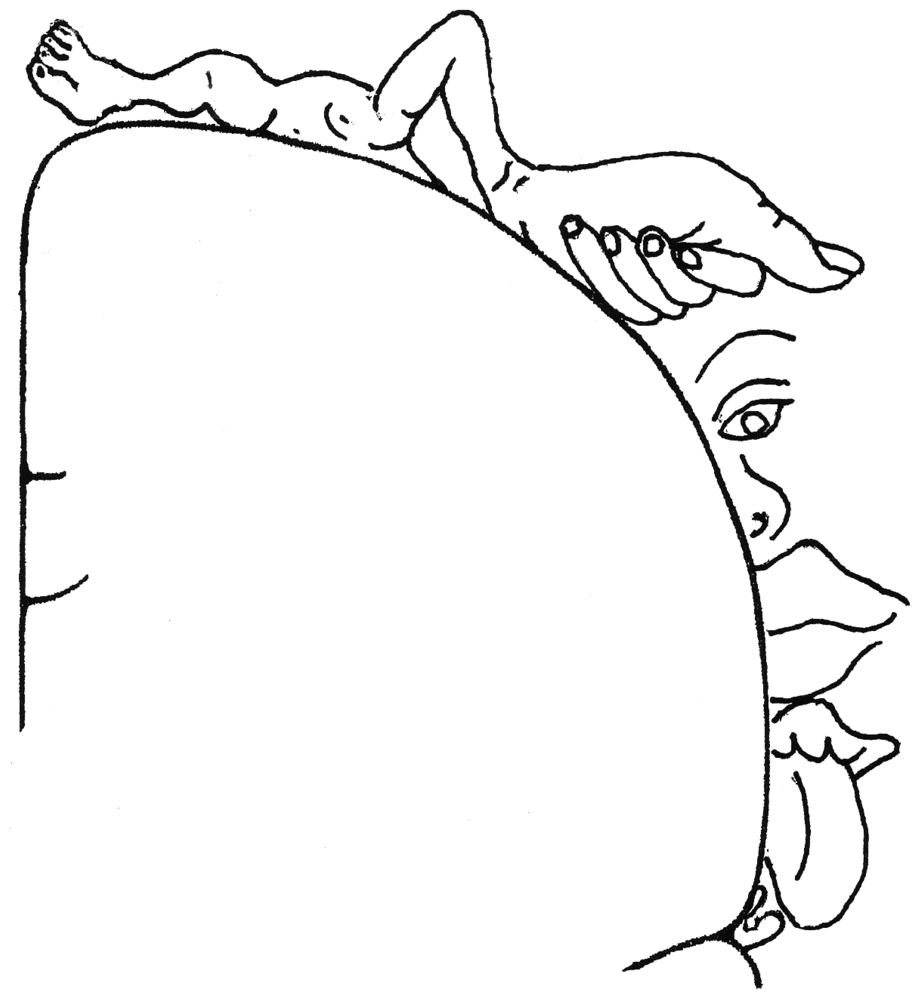Haptic
communication
Haptic
communication
is a branch of nonverbal communication that refers to the ways in which
people and animals communicate and interact via the sense of touch.
Touch is the most sophisticated and intimate of the five senses.[1]
Touch or haptics, from the ancient Greek word haptikos is extremely
important for communication; it is vital for survival.[2]
Touch is the first sense to develop in the fetus.[3] The development of
an infant's haptic senses and how it relates to the development of the
other senses such as vision has been the target of much research. Human
babies have been observed to have enormous difficulty surviving if they
do not possess a sense of touch, even if they retain sight and
hearing.[4] Infants who can perceive through touch, even without sight
and hearing, tend to fare much better.[5]
Similarly to infants, in chimpanzees the sense of touch is highly
developed. As newborns they see and hear poorly but cling strongly to
their mothers. Harry Harlow conducted a controversial study involving
rhesus monkeys and observed that monkeys reared with a "terry cloth
mother", a wire feeding apparatus wrapped in softer terry cloth which
provided a level of tactile stimulation and comfort, were considerably
more emotionally stable as adults than those with a mere wire mother.
For his experiment, he presented the infants with a clothed surrogate
mother and a wire surrogate mother which held a bottle with food. It
turns out that the rhesus monkeys spent most of their time with the
terry cloth mother, over the wire surrogate with a bottle of food,
which indicates that they preferred touch, warmth, and comfort over
sustenance.[6]
Touch can come in many different forms, some can promote physical and
psychological well-being. A warm, loving touch can lead to positive
outcomes while a violent touch can ultimately lead to a negative
outcome. The sense of touch allows one to experience different
sensations such as: pleasure, pain, heat, or cold. One of the most
significant aspects of touch is the ability to convey and enhance
physical intimacy.[7] The sense of touch is the fundamental component
of haptic communication for interpersonal relationships. Touch can be
categorized in many terms such as positive, playful, control,
ritualistic, task-related or unintentional. It can be both sexual
(kissing is one example that some perceived as sexual), and platonic
(such as hugging or a handshake). Striking, pushing, pulling, pinching,
kicking, strangling and hand-to-hand fighting are forms of touch in the
context of physical abuse.
|
触覚コミュニケーション
触覚コミュニケーションは、非言語コミュニケーションの一
分野であり、人や動物が触覚を通じてコミュニケーションや交流を行う方法を指す[1]。触覚は五感の中で最も高度で親密な感覚であり、古代ギリシャ語の
「ハプティコス」に由来する触覚(ハプティクス)はコミュニケーションにとって極めて重要であり、生存に不可欠なものである[2]。
乳児の触覚の発達と、それが視覚など他の感覚の発達とどのように関連するかは、多くの研究の対象になっている。人間の赤ちゃんは、視覚や聴覚があっても触
覚がなければ生きていくことが非常に困難であることが観察されている[4]が、視覚や聴覚がなくても触覚で知覚できる赤ちゃんは、よりうまくいく傾向があ
る[5]。
チンパンジーの触覚は、幼児と同様に非常に発達しています。新生児期のチンパンジーは、目も耳も不自由ですが、母親に強くしがみつく。ハリー・ハーロウは
アカゲザルの研究で物議をかもしたが、「テリークロスマザー」と呼ばれる針金の給餌器に柔らかいテリークロスを巻き、触覚刺激と快適さを与えたサルは、た
だの針金の母親と比べ大人になってからかなり情緒が安定することを観察している。この実験では、服を着た代理母と、餌の入った哺乳瓶を持たせた針金の代理
母を乳児に見せた。その結果、アカゲザルは餌の入った瓶を持った針金の代理母よりも、タオル地の母親と過ごす時間が多かったことから、栄養よりも触れ合い
や暖かさ、心地よさを好んだことが分かった[6]。
タッチにはさまざまな形があり、身体的、心理的な健康を促進するものもある。温かく愛情に満ちたタッチはポジティブな結果をもたらし、暴力的なタッチは最
終的にネガティブな結果につながる可能性がある。触覚は、喜び、痛み、熱さ、冷たさなど、さまざまな感覚を体験することができる。触覚は対人関係における
触覚コミュニケーションの基本的な要素である[7]。触覚はポジティブ、遊び心、コントロール、儀式的、タスク関連、または意図的でないなど、多くの用語
で分類することができる。また、性的なもの(キスは性的なものとして認識される一例)、プラトニックなもの(ハグや握手など)のいずれにもなり得る。殴
る、押す、引っ張る、挟む、蹴る、首を絞める、手と手で戦うなどは、身体的虐待の文脈におけるタッチの一形態である。
|
Categories
Heslin outlines five haptic categories:[8]
Functional/professional
- expresses task-orientation
Social/polite
- expresses ritual interaction
Friendship/warmth
- expresses idiosyncratic relationship
Love/intimacy
- expresses emotional attachment
Sexual/arousal
- expresses sexual intent
The intent of a touch is not always exclusive and touching can evolve
to each one of Heslin's categories.
|
カテゴリー
ヘスリンは、触覚のカテゴリーを次の5つに分類している[8]。
機能的/専門的
- タスク志向を表す
社会的/礼儀正しい
- 儀礼的な相互作用を表す
友情/暖かさ
- 特異な関係性を表す
愛・親密さ
- 感情的な愛着を表す
性欲・覚醒
- 性的な意図を表す
タッチの意図は必ずしも排他的ではなく、タッチはヘスリンの各カテゴリーに進化することができる。
|
Functional/professional
Managers should know the effectiveness of using touch while
communicating to subordinates, but need to be cautious and understand
how touch can be misunderstood. A hand on the shoulder for one person
may mean a supportive gesture, while it could mean a sexual advance to
another person. Working with others and using touch to communicate, a
manager needs to be aware of each person's touch tolerance.
Henley's research found that a person in power is more likely to touch
a subordinate, but the subordinate is not free to touch in kind. Touch
is a powerful nonverbal communication tool and this different standard
between a superior and subordinate can lead to confusion whether the
touch is motivated by dominance or intimacy according to Borisoff and
Victor.[9]
Walton[10] stated in his book that touching is the ultimate expression
of closeness or confidence between two people, but not seen often in
business or formal relationships. Touching stresses how special the
message is that is being sent by the initiator. "If a word of praise is
accompanied by a touch on the shoulder, that's the gold star on the
ribbon," wrote Walton.
The most common use of haptic touch in business is the handshake. A
handshake in the business world is key to giving a good first
impression. However, there are different forms of the handshake that
can be given in an appropriate situation which include: a firm
handshake (communicates confidence and strength), a limp handshake
(conveys weakness and dishonesty), a clasp (use of both hands displays
a high level of respect), and a handshake with grip (displays
intimidation and dominance).[11]
|
機能的/専門的
マネージャーは、部下とのコミュニケーションにおいて、触れ合いを使うことの有効性を知っておく必要がある。しかし、触れ合いがどのように誤解されうるか
を理解し、慎重になる必要がある。ある人が肩に手を置いたとしても、それはサポートするためのジェスチャーであり、別の人にとっては性的な誘いかけを意味
することもある。他の人と一緒に仕事をし、コミュニケーションをとるために触れ合いを使う場合、マネージャーはそれぞれの人の触れ合いの許容範囲を意識す
る必要がある。
ヘンリーの研究によると、権力者は部下に触れる可能性が高いが、部下は自由に触れることができるわけではないことがわかった。タッチは強力な非言語コミュ
ニケーションツールであり、このように上司と部下で基準が異なると、ボリソフとビクターによれば、タッチの動機が支配なのか親密なのか混乱する可能性があ
る[9]。
Walton[10]は、触れることは2人の間の親密さや信頼感の究極の表現であるが、ビジネスやフォーマルな関係ではあまり見られないとその著書の中で
述べています。タッチングをすることで、発信者のメッセージがいかに特別なものであるかが強調される。「褒めるときに肩に触れられたら、それはリボンの金
色の星だ」とウォルトンは書いている。
ビジネスにおける触覚タッチの最も一般的な使われ方は、握手である。ビジネスの世界での握手は、第一印象を良くするためのキーポイントとなる。しかし、適
切な状況で行うことができる握手にはさまざまな形があり、固い握手(自信と強さを伝える)、ぐにゃっとした握手(弱さと不誠実を伝える)、合掌(両手を使
うことで高いレベルの敬意を示す)、握手(威嚇と優位性を示す)などがある[11]
|
Social/polite
Moving from one haptic category to another can become blurred by
culture. There are many areas in the United States where a touch on the
forearm is accepted as socially correct and polite. However, in the
Midwest, this is not always an acceptable behavior.
The initial connection to another person in a professional setting
usually starts off with a touch, specifically a handshake. A person's
handshake can speak volumes about them and their personality. Chiarella
wrote an article for Esquire magazine explaining to the predominantly
male readership how handshakes differ from person to person and how
they send nonverbal messages. He mentioned that holding the grip longer
than two seconds will result in a stop in the verbal conversation, thus
the nonverbal will override the verbal communication.
A handshake is not only limited to a professional setting but as well
an important aspect of youth's team sports. Hamilton wrote that the
handshake represents the end-of-game as an embodied ritual, form of
intimate touch, and legal gesture.[12]
Jones explained communication with touch as the most intimate and
involving form which helps people to keep good relationships with
others.[13] His study with Yarbrough covered touch sequences and
individual touches.
Touch sequences fall into two different types, repetitive and
strategic. Repetitive is when one person touches and the other person
reciprocates. The majority of these touches are considered positive.
Strategic touching is a series of touching usually with an ulterior or
hidden motive thus making them seem to be using touch as a game to get
someone to do something for them.
More common than the sequential touches are the individual or single
touches. They must be read by using the total context of what was said,
the nature of the relationship and what kind of social setting was
involved when the person was touched.
Yarbrough designed a blueprint for how to touch. She designated the
different body areas as to whether they are 'touchable' or not.
Non-vulnerable body parts (NVBP) are the hand, arm, shoulder and upper
back, and vulnerable body parts (VBP) are all other body regions.
Civil inattention is defined as the polite way to manage interaction
with strangers by not engaging in any interpersonal communication or
needing to respond to a stranger's touch. Goffman uses an elevator
study to explain this phenomenon.[14] It is uncommon for people to look
at, talk to, or touch the person next to them. While it may be so
crowded that they 'touch' another person, they will often maintain an
expressionless demeanor so not to affect those around them.
|
社会的/礼儀正しい
ある触覚のカテゴリーから別のカテゴリーへの移動は、文化によって曖昧になることがある。アメリカには、前腕に触れることが社会的に正しく、礼儀正しいこ
ととして受け入れられている地域がたくさんある。しかし、中西部では、これは必ずしも受け入れられる行動ではない。
仕事の場では、他者との最初のつながりは、通常、触れること、特に握手から始まる。握手は、その人となりについて多くを語ることができる。
ChiarellaはEsquire誌に寄稿し、主に男性の読者に向けて、握手が人によってどのように異なり、どのように非言語的メッセージを送るかを説
明した。彼は、握手を2秒以上続けると、言葉による会話が止まり、非言語が言語コミュニケーションに優先すると述べている。
また、握手は仕事の場だけでなく、青少年のチームスポーツの場でも重要な要素でである。ハミルトンは、握手は体現された儀式、親密な触れ合いの形式、法的
なジェスチャーとしてゲームの終わりを表すと書いている[12]。
ジョーンズは、タッチによるコミュニケーションは、人々が他者と良い関係を保つのに役立つ最も親密で関与する形式であると説明している[13]。
タッチシークエンスは、反復的なものと戦略的なものの2種類に分類されます。反復的とは、一人がタッチし、もう一人がそれに応じることである。このような
タッチの大半は、肯定的なものであると考えられる。戦略的タッチは、通常、下心や隠れた動機を持って一連のタッチを行うため、相手に何かをしてもらうため
にゲームとしてタッチを使っているように見える。
連続したタッチよりも一般的なのは、個別または単一のタッチです。このようなタッチは、その人が何を言われたのか、どのような関係なのか、どのような社会
的環境下でタッチされたのか、などの文脈を総合して読み取る必要がある。
ヤーブローは、タッチの仕方の青写真を描きました。彼女は、身体のさまざまな部位を、「触れられる」か「触れられない」かに分けて説明した。非脆弱な身体
部位(NVBP)とは手、腕、肩、背中上部を指し、脆弱な身体部位(VBP)とはそれ以外の身体部位を指す。
市民的無関心(=儀礼的無関心)とは、見知らぬ人との交流を管理するために、対人コミュニケーションを一切とらない、あるいは見知らぬ人の接触に反応する
必要がないという礼儀作法と定義される。ゴフマンはこの現象を説明するためにエレベーターの研究 を用いている[14]
。他の人に「触れる」ほど混雑していても、周りの人に影響を与えないように無表情でいることが多い。
|
Friendship/warmth
It is more acceptable for women to touch than men in social or
friendship settings, possibly because of the inherent dominance of the
person touching over the person being touched. Women and girls are
commonly known for interacting with each other through touch than men
and boys do as same-sex touch is acceptable for women.[15] Whitcher and
Fisher conducted a study to see whether friendly touch in a healthcare
setting reduced anxiety equally or differently between men and
women.[16] A nurse was told to touch patients for one minute while the
patients looked at a pamphlet during a routine preoperative procedure.
Females reacted positively to the touch, whereas males did not. It was
surmised that males equated the touch to being treated as inferior or
dependent.
Touching among family members has been found to affect the behavior of
those involved. Touch is a way that a child can express positive
emotion. For example, physical affection, like hugs, can serve as an
overt display of love. Various factors are at work within a family
setting. As a child grows older, the amount of touching by the parent
decreases although it does continue to be an important social behavior
for that child to communicate positive or negative emotions later in
their future.[17]
A study of nonverbal communication on how men 'converse' in bars shows
that women like men to touch, but it is their touching of other men
that intrigues them. The men who are touching others are perceived as
having a higher status and social power than those that aren't touching
others.
The study found that women were more receptive to men who demanded the
most social space and that when a woman comes into a bar, men will move
their drinks far apart to signal to her that they have space in their
'domain' for them.[citation needed]
|
友情・温もり
社会的または友好的な場では男性よりも女性の方が触れ ることが許容されるが、これはおそらく触れる人が触られる人
よりも優位に立つという性質があるためであろう。ウィッチャーとフィッシャーは、医療現場でのフレンドリーなタッチが不安を減らすかどうかを確かめるため
に、男女間で同等または異なる研究を行いました[16]。女性はこのタッチにポジティブな反応を示したが、男性はそうではなかった。これは、男性が触られ
ることを、劣ったものとして扱われることと同一視しているためと推測される。
家族間の触れ合いは、関係者の行動に影響を与えることが分かっています。タッチは、子どもがポジティブな感情を表現する方法のひとつである。例えば、ハグ
のような身体的な愛情は、あからさまな愛情表現として機能することがある。家族という環境では、さまざまな要因が作用しています。子どもが成長していくに
つれて、親による触れ合いの量は減少していくが、子どもが将来、肯定的または否定的な感情を伝えるための重要な社会的行動であり続ける[17]。
バーで男性がどのように「会話」するかという非言語コミュニケーションの研究によると、女性は男性に触れるのが好きだが、女性が興味をそそられるのは他の
男性に触れることであることがわかった。他の人に触れている男性は、他の人に触れていない男性よりも高い地位と社会的な力を持っていると認識されるので
す。
この研究では、女性は最も社会的なスペースを要求する男性に対してより受容的であり、女性がバーに入ってくると、男性は自分の「領域」に自分のためのス
ペースがあることを彼女に示すために飲み物を遠くに移動させることがわかった[citation needed]。
|
Love and intimacy(→Physical
intimacy)
|
|
Healthy touch
The primary nonverbal behavior that has the biggest effect on
interpersonal relationships is touch. The amount of touching increases
as a relationship moves from impersonal to personal.
Three areas of public touch between couples have been studied: the
amount of touch between a couple in the initial stages of a romantic
relationship; how much touching goes on between the couple, and the
extent of touching with the amount of touch men and women displayed and
who initiated the touch and when they initiated it.
Public touch can serve as a tie sign that shows others that one's
partner is "taken".[18] When a couple is holding hands or putting their
arms around each other, this is a tie sign showing others that they are
together. Tie signs are used more often by couples in the dating and
courtship stages than between their married counterparts according to
Burgoon, Buller, and Woodall.[19]
Studies have also shown a difference between the sexes on who touches
when. In the initial stages of a relationship, men often follow
socially prescribed gender roles. Patterson indicated that men
fulfilling this social role would touch more and after initial touch in
casual relationships and as the relationship became more intimate
during serious dating or marriage relationships, women would touch
more.[20] American culture still dictates that men "make the first
move" in the context of dating and relationships.
Touching between married couples may help maintain good health. In a
study by University of Virginia psychologist Jim Coan, women under
stress showed signs of immediate relief by merely holding their
husband's hand. This seemed to be effective when the woman was part of
a satisfying marriage.
|
健康的な触れ合い
対人関係に最も大きな影響を与える非言語的行動の第一は、触れることです。非人間的な関係から個人的な関係に移行するにつれて、触れ合いの量は増加する。
カップル間の公的タッチについては、恋愛関係の初期段階におけるカップル間のタッチの量、カップル間でどの程度タッチが行われるか、男女が示したタッチの
量と誰がいつタッチを開始したかというタッチの程度という3つの領域が研究されている。
公共の場でのタッチは、自分のパートナーが「連れて行かれた」ことを他人に示すタイサインの役割を果たすことがある[18]。カップルが手をつないだり腕
を回したりしているとき、これは二人が一緒にいることを他人に示すタイサインである。ブルグーン、ブラー、ウッドオールによると、タイサインは既婚者間よ
りもデートや求愛段階のカップルでより頻繁に使われている[19]。
また、誰がどのようなタイミングでタッチするかについても、男女間で違いがあることが研究により明らかになっている。交際の初期段階では、男性は社会的に
規定された性別の役割に従うことが多い。パターソンは、この社会的役割を果たす男性がより多く触れ、カジュアルな関係で最初に触れた後、真剣なデートや結
婚関係で関係がより親密になるにつれ、女性がより多く触れることを示した[20]。アメリカ文化は、デートや関係において男性が「最初の動きをする」こと
をまだ規定している。
夫婦間の触れ合いは健康維持に役立つかもしれない。バージニア大学の心理学者ジム・コーンの研究では、ストレスにさらされている女性は、夫の手を握るだけ
ですぐに安心する兆しを見せたという。これは、その女性が満足のいく結婚生活を送っている場合に有効なようである。
|
Violence
Touching in intimate relationships may also be violent at times. McEwan
and Johnson categorize violent touch in relationships into two
categories: intimate terrorism and common couple violence.[21] Intimate
terrorism is characterized by an escalating need to control or dominate
a relationship with high frequency and severity. Common couple
violence, on the other hand, is often a result of minor conflict, is
less frequent and severe, and does not escalate over time.
|
暴力
親密な関係における接触は、時に暴力的であることもある。McEwanとJohnsonは、関係における暴力的な接触を、親密なテロリズムと一般的なカッ
プル暴力という2つのカテゴリーに分類している [21]
。親密なテロリズムは、高い頻度と深刻さで関係をコントロールしたり支配したりする必要がエスカレートすることによって特徴づけられる。一方、一般的な
カップルの暴力は、しばしば些細な衝突の結果であり、頻度も深刻さも低く、時間とともにエスカレートすることはない。
|
Sexual/arousal
According to Givens, the process of nonverbal communication or
negotiation is to send and receive messages in an attempt to gain
someone's approval or love. Courtship, which may lead to love, is
defined as a nonverbal message designed to attract sexual partners.
During courtship, we exchange nonverbal communication gestures to tell
each other to come nearer and nearer until we touch. Essential signals
in the path to intimacy include facial nuzzles, kissing and caressing
each other.
Courtship has five phases which include the attention phase,
recognition phase, conversation phase, touching phase, and the
love-making phase. Haptics takes place more during the last two phases.
The touching phase:
First touch: Is likely to be more "accidental" than premeditated by
touching a neutral body part and where the recipient either accepts the
touch or rejects it through body movement.
Hugging: The embrace is the most basic way of telling someone that you
love them and possibly need them, too.
Intention to touch: A nonverbal communication haptic code or cue is the
intention behind it. Reaching your hand across the table to a somewhat
unknown person is used as a way to show readiness to touch.
Kissing: Moving in concert by turning heads to allow for the lips to
touch is the final part of the fourth stage of courtship, the kiss.
The final phase, love-making, which includes tactile stimulation during
foreplay known as the light or protopathic touch. Any feelings of fear
or apprehension may be calmed through other touching like kissing,
nuzzling, and a gentle massage.
|
性的/性的興奮
ジブンスによると、非言語コミュニケーションや交渉のプロセスは、誰かの承認や愛を得るためにメッセージを送ったり受け取ったりすることである。恋愛に発
展する可能性のある求愛は、性的パートナーを惹きつけるためにデザインされた非言語メッセージと定義されている。求愛中は、非言語コミュニケーションの
ジェスチャーを交わして、「触れるまでもっともっと近づいて」と伝え合う。親密な関係になるための重要なシグナルには、顔をうずめる、キスをする、愛撫を
するなどがある。
求愛には5つの段階があり、注意段階、認識段階、会話段階、接触段階、そして愛を育む段階である。ハプティクスは最後の2つのフェーズでより多く行われ
る。
タッチングフェーズ
ファーストタッチ: 中立的な体の部位に触れることで、計画的というよりは "偶然
"である可能性が高く、受け手は体の動きによってその接触を受け入れるか拒否するかのどちらかである。
ハグをする。抱擁は、相手に「愛している」「必要だ」ということを伝える最も基本的な方法である。
触覚の意図
非言語コミュニケーションの触覚コードやキューは、その背後にある意図のことである。テーブルの向こうのやや知らない人に手を差し伸べることは、触れる準
備ができたことを示す方法として使われる。
キスをする。唇が触れるように頭を回転させながら協調して動くのが、求愛の第4段階の最後の部分であるキスである。
最終段階であるラブメイキングでは、ライトタッチやプロトパシックタッチと呼ばれる前戯での触覚刺激が含まれる。恐怖や不安の感情は、キスやナズリング、
優しいマッサージなど、他の触れ合いによって鎮めることができるかもしれない。
|
Context of touch
There are various contexts and dimensions that touch can interpret.
These dimensions that many have described include intensity, duration,
location, frequency, and instrument of touch.
Intensity: relates to how delicate or how strong the touch is.
Duration: relates to how short or prolonged the touch was.
Location: refers to the area where the person was touched.
Frequency: represents the number of touches that happen.
Instrument of touch: refers to the touch with other body parts like
feet, lips, and other objects as well.[22]
|
タッチの文脈
タッチには様々な文脈と次元があります。これらの次元には、強さ、持続時間、場所、頻度、触覚の道具などが含まれます。
強度:タッチがどれだけ繊細か、またはどれだけ強いかに関係する。
持続時間:タッチがどれだけ短かったか、または長かったかに関係する。
場所: 触られた場所を指します。
頻度: 何回触られたかを表します。
触覚の道具:足や唇など、他の体の部位や他の物との触れ合いを指す[22]。
|
Meanings
Touch research conducted by Jones and Yarbrough revealed 18 different
meanings of touch, grouped in seven types: Positive affect (emotion),
playfulness, control, ritual, hybrid (mixed), task-related, and
accidental touch.
Positive affect
These touches communicate positive emotions and occur mostly between
persons who have close relationships. These touches can be further
classified as support, appreciation, inclusion, sexual interest or
intent, and affection. Research has shown that hugging can reduce
levels of the stress hormone cortisol.[23]
- Support: Serve to nurture, reassure, or promise protection. These
touches generally occur in situations which either virtually require or
make it clearly preferable that one person show concern for another who
is experiencing distress.
- Appreciation: Express gratitude for something another person has done.
- Inclusion: Draw attention to the act of being together and suggest
psychological closeness.
- Sexual: Express physical attraction or sexual interest.
- Affection: Express generalized positive regard beyond mere
acknowledgment of the other.
Playful
These touches serve to lighten an interaction. These touches
communicate a double message since they always involve a play signal,
either verbal or nonverbal, which indicates the behavior is not to be
taken seriously. These touches can be further classified as
affectionate and aggressive.
Playful affection: Serve to lighten interaction. The seriousness of the
positive message is diminished by the play signal. These touches
indicate teasing and are usually mutual.
Playful aggression: Like playful affection these touches are used to
serve to lighten interaction, however, the play signal indicates
aggression. These touches are initiated, rather than mutual.
Control
These touches serve to direct the behavior, attitude, or feeling state
of the recipient. The key feature of these touches is that almost all
of the touches are initiated by the person who attempts influence.
These touches can be further classified as compliance,
attention-getting, and announcing a response.
- Compliance: Attempts to direct behavior of another person, and often,
by implication, to influence attitudes or feelings.
- Attention-getting: Serve to direct the touch recipient's perceptual
focus toward something.
- Announcing a response: Call attention to and emphasize a feeling
state of initiator; implicitly requests affect response from another.
Ritualistic
These touches consist of greeting and departure touches. They serve no
other function than to help make transitions in and out of focused
interaction.
- Greeting: Serve as part of the act of acknowledging another at the
opening of an encounter.
- Departure: Serve as a part of the act of closing an encounter
Hybrid
These touches involve two or more of the meanings described above.
These touches can be further classified as greeting/affection and
departure/affection.
Greeting/affection: Express affection and acknowledgement of the
initiation of an encounter
Departure/affection: Express affection and serve to close an encounter
Task-related
These touches are directly associated with the performance of a task.
These touches can be further classified as:
- Reference to appearance: Point out or inspect a body part or artefact
referred to in a verbal comment about appearance
- Instrumental ancillary: Occur as an unnecessary part of the
accomplishment of a task
- Instrumental intrinsic: Accomplish a task in and out of itself i.e.,
a helping touch.
Accidental
These touches are perceived as unintentional and have no meaning. They
consist mainly of brushes. Research by Martin in a retailing context
found that male and female shoppers who were accidentally touched from
behind by other shoppers left a store earlier than people who had not
been touched and evaluated brands more negatively, resulting in the
Accidental Interpersonal Touch effect.[24]
|
意味
JonesとYarbroughが行ったタッチの研究では、タッチの意味が18種類あり、7つのタイプに分類されていることが明らかになりました。ポジ
ティブな感情、遊び心、コントロール、儀式、ハイブリッド(混合)、タスク関連、偶発的なタッチ。
ポジティブな感情
ポジティブな感情を伝えるタッチであり、主に親しい間柄で行われる。これらのタッチはさらに、サポート、感謝、包含、性的な興味や意図、愛情に分類するこ
とができます。研究によると、ハグはストレスホルモンのコルチゾールのレベルを下げることができます[23]。
- サポート
育む、安心させる、または保護を約束するために奉仕する。これらの接触は一般に、苦痛を経験している他者に対して、ある人が関心を示すことが事実上必要で
あるか、明らかに望ましい状況において発生する。
- 感謝。他の人がしてくれたことに感謝の意を表す。
- 包容力。一緒にいるという行為に注意を向けさせ、心理的な親密さを示唆する。
- 性的。肉体的な魅力や性的な関心を表す。
- 愛情。相手を単に認めるだけでなく、一般的な肯定的評価を表現する。
遊び心
これらのタッチは、相互作用を軽くするためのものです。これらのタッチは、常に言語的または非言語的な遊びの合図を伴うため、二重のメッセージを伝えるこ
とになります。これらのタッチは、さらに愛情的なものと攻撃的なものに分類することができる。
遊び心のある愛情。相互作用を軽くする役割を果たす。ポジティブなメッセージの真剣さが、遊びの合図で薄れる。このような接触はからかいを意味し、通常、
相互に影響し合う。
遊び半分の攻撃。遊びの愛情表現と同様に、これらのタッチは相互作用を軽くするために使われますが、遊びのシグナルは攻撃性を表します。このようなタッチ
は、お互いにではなく、自分から行うものです。
コントロール
相手の行動や態度、気持ちをコントロールするためのタッチです。これらのタッチの大きな特徴は、ほとんどのタッチが影響を与えようとする人によって始めら
れたものであることです。これらのタッチは、さらにコンプライアンス、アテンションゲッティング、アナウンスメントアンサーに分類することができる。
- コンプライアンス。他人の行動を指示しようとすることで、しばしば暗黙のうちに態度や感情に影響を与える。
- 注意を引くこと。タッチを受けた人の知覚の焦点を何かに向けること。
- 反応を知らせる。開始者の感情状態に注意を促し強調する。
儀式的タッチ
これらのタッチは、挨拶と出発のタッチで構成されています。これらのタッチは、集中した相互作用への出入りを助ける以外の機能はない。
- 挨拶。出会いの始まりに相手を認める行為の一部として機能する。
- 出発。出会いを閉じる行為の一部として機能する。
ハイブリッド
上記のような2つ以上の意味を持つタッチ。さらに、挨拶・愛想と出発・愛想に分類することができる。
挨拶・愛想。愛情表現、出会いを認める表現
出発・愛情。愛情を表現し、出会いを終わらせる
タスク関連
このタッチは、タスクの遂行に直接関連するタッチです。このタッチは、さらに次のように分類される。
- 外見への言及。外見に関する言及:外見に関する口頭でのコメントで言及された体の部位や道具を指摘したり、点検したりする。
- 道具的な補助的なもの。タスクの達成に不必要な部分として発生する。
- 道具的内在性:それ自体でタスクを達成すること。
偶発的
これらのタッチは意図的でないものとして認識され、何の意味もありません。主にブラシで触られることが多い。マーティンによる小売の文脈での研究では、他
の買い物客に偶然後ろから触れられた男女の買い物客は、触れられなかった人よりも早く店を出て、ブランドをより否定的に評価し、偶然の対人接触効果をもた
らすことがわかった[24]。
|
Culture
The amount of touching that occurs within a culture is largely based on
the relative high context or low context of the culture.
High contact
In a high contact culture, many things are not verbally stated but are
expressed through physical touch. For instance, Cheek kissing is a very
common method of greeting in Latin America, but among Northern
Europeans it is an uncommon form of greeting. Different cultures have
different display rules, the degree with which emotions are expressed.
Cultural display rules also affect the degree to which individuals
share their personal space, gaze and physical contact during
interactions. In a High contact culture, such as South America, Latin
America, Southern Europe, Africa, Russia, the Middle East and others,
people tend to share more physical contact. High contact cultures
communicate through long gazes, long hugs, and share a decrease in
proxemics.[25]
Low contact
Low contact cultures such as: The United States, Canada, Northern
Europe, Australia, New Zealand and Asia prefer infrequent touching,
larger physical distance, indirect body orientations (during
interaction) along with little share gazes.[25] In the Thai culture,
kissing a friend on the cheek is less common than in the Latin
Americas. Remland and Jones studied groups of people communicating and
found that in England (8%), France (5%) and the Netherlands (4%),
touching was rare compared to the Italian (14%) and Greek (12.5%)
samples.[26]
Internal differences
Frequency of touch also varies significantly between different
cultures. Harper refers to several studies, one of which examined
touching in coffee houses. During a one-hour sitting 180 touchings were
observed for Puerto Ricans, 110 for French, none for English and 2 for
Americans. (Harper, 297). In order to know if someone was touching more
frequently than normal it would be necessary to first know what is
normal in that culture. In high touch countries a kiss on the cheek is
considered a polite greeting while in Sweden it may be considered
presumptuous. Jandt relates that two men holding hands will in some
countries be a sign of friendly affection, whereas in the United States
the same tactile code would probably be interpreted as a symbol of
homosexual love.
Emotion and touch
Recently, researchers have shown that touch communicates distinct
emotions such as anger, fear, happiness, sympathy, love, and
gratitude.[27] Moreover, the accuracy with which subjects were capable
of communicating the emotions were commensurate with facial and vocal
displays of emotion.[28]
Depression has been linked to touch deprivation in adults and research
has established associations between touch deprivation and eating
disorders. Men have been found more likely to experience touch
deprivation than women due to stronger social prohibitions against
same-sex touching among adult males.[29]
|
文化
ある文化の中で起こる触れ合いの量は、その文化の相対的な高コンテクストか低コンテクストかに大きく依存する。
高い接触
接触性の高い文化では、多くの物事が口頭で述べられるのではなく、身体的な接触によって表現されます。例えば、ラテンアメリカでは頬にキスをすることは非
常に一般的な挨拶ですが、北欧の人々の間では珍しい挨拶方法なのです。文化が異なれば、感情をどの程度表現するかという表示ルールも異なる。文化的な表示
規則は、個人がパーソナルスペースや視線、身体的接触をどの程度共有するかにも影響する。南米、ラテンアメリカ、南ヨーロッパ、アフリカ、ロシア、中東な
どの高接触文化圏では、人々はより多くの身体的接触を共有する傾向があります。高接触文化は長い視線、長い抱擁を通してコミュニケーションをとり、プロキ
シミクスの減少を共有する[25]。
低コンタクト
低コンタクト文化は以下のようなものです。アメリカ、カナダ、北欧、オーストラリア、ニュージーランド、アジアは、頻繁でない接触、より大きな物理的距
離、間接的な体の向き(相互作用の間)、ほとんど共有しない視線を好みます[25]。タイ文化では、頬へのキスはラテンアメリカに比べてあまり一般的では
ありません。レムランドとジョーンズはコミュニケーションをとる人々のグループを研究し、イギリス(8%)、フランス(5%)、オランダ(4%)では、イ
タリア(14%)とギリシャ(12.5%)のサンプルと比較して、触れることはまれであることを発見しました[26]。
内的な違い
触れる頻度もまた、文化によって大きく異なる。ハーパーはいくつかの研究を紹介し、そのうちの1つはコーヒーハウスでの触れ合いを調査したものである。1
時間の間に、プエルトリコ人は180回、フランス人は110回、イギリス人はゼロ、アメリカ人は2回の接触が観察された。(ハーパー、297)。誰かが普
通より頻繁に触れているかどうかを知るには、まずその文化で何が普通かを知る必要がある。接触が多い国では、頬へのキスは丁寧な挨拶とみなされるが、ス
ウェーデンではおこがましいとみなされることもある。Jandtは、ある国では二人の男性が手をつなぐことは友好的な愛情のしるしであるが、アメリカでは
同じ触覚のコードはおそらく同性愛の愛の象徴と解釈されるだろうと述べている。
感情と触覚
近年、触覚は怒り、恐怖、幸福、同情、愛、感謝などの明確な感情を伝達することが研究者によって示されています[27]。
さらに、被験者がこれらの感情を伝達することができる正確さは、顔や声による感情の表現に比例していました[28]。
うつ病は成人における触覚遮断と関連しており、触覚遮断と摂食障害との
関連も研究により確立されている。成人男性における同性間の接触に対するより強い社会的禁忌のため、男性は女性よりも触覚遮断を経験する可能性が高いこと
が分かっている[29]。
|
Consoling touch
Haptic perception
Physical intimacy:
Holding hands
Tickling
Kissing
Making out
Massage
Erotic massage
Human sexual activity
Other touch:
Frotteurism
Groping
Personal boundaries
Cultural studies
Edward T. Hall
Bertram Raven
Negiah
|
心地よい手触り
触覚
肉体的な親密さ:
手をつなぐ
くすぐる
キスをする
イチャイチャする
マッサージ
エロマッサージ
人間の性行為
他のタッチ
窃触症(Frotteurism)
性的いじり(Groping)
個人の境界線
文化研究
エドワード・T・ホール
バートラム・レイヴン
ネジア
|
https://en.wikipedia.org/wiki/Haptic_communication
|
https://www.deepl.com/ja/translator
|








